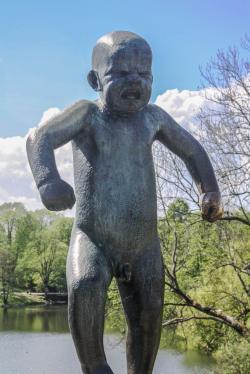Walking around Oslo is the best way to soak in the laid-back atmosphere of Norway’s capital city, its idyllic location at the northern tip of Oslofjorden, and the Norwegians themselves, a warm, welcoming lot with a subtle and self-deprecating sense of humor. It’s also the best way to appreciate one of the most charming features of the city—a seemingly obsessive fascination with statues. Simply put, they’re everywhere. They’re delightful, classical, whimsical: The regal Queen Maud in front of the Royal Palace, the curious forearm and hand of Christian IV pointing to where the city was to be rebuilt after the fire of 1624, a couple sitting at one of the outdoor tables at a restaurant, a man on stilts in the middle of an artificial pool, composer Edvard Grieg next to a gazebo. Oslo is also the only place I’ve ever been that has honored poultry with a statue.

The remarkable Art Nouveau gate greets visitors on their way into one of the world’s greatest outdoor sculpture parks.
The best collection of statues resides in the 111-acre Frogner Park, the city’s largest, most popular park. The centerpiece is Vigelandsparken, the world’s largest sculpture park made by a single artist.
Gustav Vigeland was the Norwegian sculptor who designed the Nobel Peace Prize medal. Even though I’m usually a pacifist, I am an unlikely candidate to ever receive that accolade, so I decided to see some of his more accessible work by making the park my destination point of a pleasant walk of just under two miles from the terrific City Hall.
The Main Gate to the park is an Art Nouveau wonder. Designed in 1926 and erected in 1942, the gate comprises five large gates and two smaller pedestrian gates. Combining granite and wrought iron, surmounted by lanterns, and punctuated at either end by gatehouses topped with copper roofs, the gate is a graceful entrance to the park, which receives more than one million visitors per year.
Passing through the gate, I began my leisurely stroll up the grassy promenade flanked by trees. The impeccable design of the park quickly became apparent and would reaffirm itself as I continued, with each feature and attraction building in dramatic fashion toward the ultimate highlight.
Vigeland spent most of the 1920s and 1930s creating both the park and the sculptures that inhabit it. Today, his 212 bronze and granite works are arranged over 80 acres, the first of which make their appearance on the bridge over a tranquil pond. Like a newer version of Prague’s Charles Bridge, this bridge is lined with lanterns and several dozen bronze sculptures of nude men, women, and children. Some of the figures are in motion, some are stationary; some stand alone, others are in pairs. Both simple and complex, they’re like 3-D photos of everyday life, photos you may have of your friends and family. Their titles are clear and straightforward: Man Swinging Boy, Elderly and Younger Man, Angry Boy, Little Laughing Girl, Man With Boy Around Neck, Woman With Infant in Her Arms, Two Boys Running With Arms Towards the Sky. Sculpted in a uniform and unmistakably Nordic style, they convey a very human spirit that’s truly engaging, and very relatable.
The bridge crosses to a tidy, open plaza crisscrossed by angled paths that leads to the Fountain. Standing in the center of a rectangular pool, a group of bronze figures supports a large bowl over their heads, water pouring out all around them. Twenty bronze trees interwoven with figures, from infants to skeletons, frame the pool, representing the entire cycle of life and dripping with symbolism: water giving life, the tree of life, from death comes life. A black-and-white granite mosaic almost 20,000 square feet in size surrounds the entire feature.
All of this builds to Vigeland’s masterpiece. Beyond the Fountain and through another set of wrought-iron gates laced with human figures, I climbed the stairs of one of the two symmetrical stepped terraces, past the highly stylized floral arrangements, to the highest point of the park, the oval-shaped Monolith Plateau. At the center of the plateau, I took in the 46′-tall Monolith. As my eyes traveled up this granite tower toward the sky, so the 121 figures on it stood, climbed, and embraced each other as they, too, headed toward the sky, on their way to salvation.
Neatly placed on the circular stairs rising to the Monolith, more than 30 granite figure groups continue Vigeland’s depiction of life, and he didn’t limit them to the more pleasant or romantic aspects of it; he wanted the full gamut of our condition. So, among such figures as the tender Man and Woman Sitting With Baby Between Them, the playful Boy and Girl Riding on Woman’s Back, and the joyful Five Girls Kneeling Behind Each Other, there’s also the angry Boys Fighting, shameful Two Boys Teasing an Imbecile Man, and sorrowful Old Woman and Young Man (Mother and Son), as a concerned elderly woman comforts her distraught son, perhaps over a lost lover, or the death of a friend, or some unnamed terrible disappointment.
From this high vantage point, I was able to look down on the entire path I had just walked and spy the occasional church spire poking out above the treetops. As I contemplated all of the park’s life depicted in stone and metal, I also saw the life in flesh and bone around me—happy children clambering on the sculptures, elderly folk moving with some difficulty, content lovers, parents who seemed a little stressed, siblings disagreeing—and I realized that Vigeland had perfectly captured humanity at its most ordinary, which, ultimately, turns out to be its most remarkable.




Pingback: Life in Bronze and Granite in Oslo’s Vigeland Park | Stephen Travels
Pingback: First-rate Dining at Café Christiania in Oslo, Norway | Stephen Travels